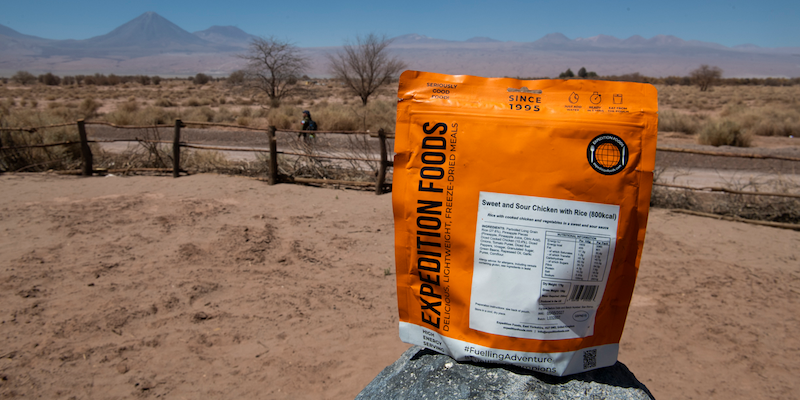-
Meals
-
Ration Packs
-
Special Diets
- Survivor Foods 25-Year Tins
-
Snacks, Drinks & Accessories
- About Us
LEARNING THE ROPES: INSIGHTS FROM EXPEDITION CLIMBING
November 24, 2023
The Himalaya. India. These two words are so evocative, so rich in colour and anticipation. I just knew I had to go. Kyrgyzstan in 2021 had been an adventure and a personal proof of concept; Tajikistan in 2022 had been successful yet heart-breaking, as I had to withdraw due to illness. It was time to return to the Greater Ranges, and the Indian Himalaya was calling.

Photo 1: Dinner time at high camp (5200m) on Nevado Copa (6188m) in the Cordillera Blanca, Peru. August 2023.
Starting in August 2022, I spent hours poring over maps and previous expedition reports, contacting support agencies, and building a team of passionate climbers seeking an adventure.
Fast-forward to June 2023 and I am sat in a bivouac tent in the shadow of the Grand Capucin, Chamonix with a fantastic team of talented climbers, and everyone is excited for our trip to India in just a few months’ time.

Photo 2: Sam Poletti and Tom Davis-Merry, Aiguille d'Entrèves Traverse (AD- 4c), expedition training in Chamonix, France. June 2023.
INTERNATIONAL NORTH SIKKIM EXPEDITION 2023
In September 2023, the International North Sikkim Expedition 2023 team arrived in Delhi before travelling to the Yumthang valley, North Sikkim for five weeks. We were an international mixed ensemble of six young Alpinists, seeking first ascents of three unclimbed 5000m peaks in a previously unexplored region of the complex Brumkhangse glacial system.
The last three years have been a steep learning curve and learning the ropes of expedition climbing has been a hugely rewarding personal journey.
This adventurous mountaineering discipline brings together leadership and team building, complex planning and logistics, and navigating the minutiae of Byzantine bureaucratic corridors.
Below I wish to share some of what I have learnt about building climbing teams, the challenges of expedition planning, and developing an expedition style.

Photo 3: Tom Davis-Merry enjoying late breakfast during a rest day on Nevado Pisco (5752m) in the Cordillera Blanca, Peru. August 2023.
BUILDING AN EXPEDITION TEAM
When building an expedition team, personality and character can weigh just as importantly as climbing experience. Resilience, humour, and teamwork are essential. You will be spending weeks together in harsh environments and when you are cold and exhausted, you need to be able to work together and keep each other in good spirits. Building an international team of climbers you haven’t met before in person can be challenging, but get it right and you will forge friendships for life.

Photo 4: Elie Jaumin, Aiguille d'Entrèves Traverse (AD- 4c), expedition training in Chamonix, France. June 2023.
Collaborate on expedition planning and share the work. For this trip we have team members living in the UK, Switzerland, Italy, and Germany. Likewise, when planning for Kyrgyzstan in 2021, the global pandemic meant that meeting in person was impossible until restrictions were eased only shortly before we flew out to Bishkek.
Take advantage of collaborative online working spaces, so that everyone can access planning documents and mapping. Similarly, fantastic digital tools such as FATMAP allow for collaborative research and planning.
It’s vital all your team members feel a real sense of ownership for the expedition; delegate tasks as much as possible and give team members responsibility to lead on specific areas, such as sponsorship or evacuation planning. Ensure you curate a culture within the group where decisions are made as a team, both in the planning phases and, critically, when on the mountain.
Some aspects, such as the selection of objectives and climbing style, will require total investment from the whole team, as this can define the very purpose and nature of your expedition.

Photo 5: Sarah Wysling, Chris Lewis, and Alex Metcalfe, making first ascents in the Pamirs, Tajikistan. August 2022.
Understand how potential team members approach risk. Risk is typically defined as the potential impact of an unintended event, and the likelihood of that event happening. Different people will have different perceptions of, and attitudes towards, risk in mountaineering.
Risks commonly encountered in expedition climbing will range from rock fall and bad weather to disease outbreaks or political instability that can throw off your travel plans.
How we perceive the risks associated with a certain situation will vary between team members; there will be a natural variation in how we judge the potential severity of certain events and assess how likely those events are to happen.
Also differing between team members is our willingness to accept different levels of risk, our risk appetite; some are more comfortable with accepting a higher or lower degree of risk than others.
It is important to understand the profile of risk perception and appetite across the team and keep a healthy balance in check. Risk is inherent in mountaineering, so keep in mind how the context of an expedition will amplify the potential impact of any difficult events that might occur.

Photo 6: Dinner time at Moraine Camp (5100m) on Nevado Pisco (5752m) in the Cordillera Blanca, Peru. August 2023
Every effort should be made to train and climb together as a team. Ideally, in challenging conditions akin to what you might expect to find on the expedition. Not only is this a brilliant opportunity to bond as a team and enjoy climbing together, but also a chance to better understand the different characters and personalities within the team.
You can get a feel for these different attitudes towards risk and reward, appreciate potential areas of friction or disagreement, and understand the different strengths within the team that will all contribute towards a successful trip.

Photo 7: Elie Jaumin, Tom Davis-Merry, and Sam Poletti, overlooking the Vallée Blanche, Chamonix, France. June 2023.
DEVELOPING AN EXPEDITION STYLE
Understanding what is a realistic objective. When you’re exhausted from the toils of expedition life, several days from rescue or medical assistance, and with no guidebook description to show you the way, any route can feel a lot harder.
AD+ on Chamonix granite with a warm hut bed and a cable car to the valley, is not the same as AD+ on a remote unclimbed peak with a cold, cramped tent several days’ hike from basecamp. Although the latter is arguably far more exciting!
Think about the style and ethics of your expedition. Are you a large team supported by several staff and a big comfortable basecamp, or a pair of climbers carrying everything on your back. Or perhaps a hybrid of these two approaches. You might choose to have a supported basecamp at a lower altitude, perhaps accessible by vehicle, and then operate self-sufficiently at advanced basecamp and above. We found such an approach worked well for us in Kyrgyzstan in 2021.
Are you looking to explore a new area with several moderate-graded peaks, or are you set on a steep line on the exposed face of a single unclimbed objective. You may find the former grants a greater degree of flexibility, especially for your first big trip. Consider too your environmental policy, tipping of support staff, carbon offsetting, climbing ethics, and understanding of local cultures and customs.

Photo 8: Sam Davis, Thomas Simpson, and Alex Metcalfe, collecting water at advanced basecamp (4100m) in the Tian Shan, Kyrgyzstan. August 2021.
Ease of access, available logistics support, and cost. Kyrgyzstan has several highly reputable agents that can support you with basecamp infrastructure and staff, whilst there is not a single agent in Tajikistan that can provide you with a mess tent. Neither are basecamp cooks available in Tajikistan, whilst in Kyrgyzstan this is a recognised profession.
In India, local regulations require you to have a basecamp cook, cook’s assistant, Liaison Officer, and local guide. In Afghanistan, for example, you will likely also require an interpreter.
Logistics support costs in India are roughly twice that of Tajikistan, and Kyrgyzstan sits somewhere in the middle. It’s worth weighing up such factors, along with the style and ethics of your expedition, when choosing the region you wish to visit.

Photo 9: Dinner time at high camp (4300m) on Nevado Maparaju (5326m) in the Cordillera Blanca, Peru. August 2023.
MAKING IT ALL HAPPEN
Get a solid logistics agent. Having a reliable in-country agent or ‘fixer’ is essential. Not only can they assist with the early stages of research and objective selection, but they can arrange all manner of support from vehicles, drivers, and accommodation to peak permits, visa application documents, and navigating opaque local bureaucracy.
Consider using an agent to provide your basecamp infrastructure and staff, minimising how much kit you must fly into the country, and ensuring you have ample fresh food when resting at lower altitudes. Your agent will also arrange for Liaison Officers, interpreters, and local guides, as might be required by the country or region you wish to explore.
Find out which agents earlier teams have used by reading previous expedition reports, for which the Mount Everest Foundation website is a superb resource.
Finance, grants, and sponsorship. Getting sponsorship for expeditions is hard work, but it’s hugely rewarding and can make a big difference to the success of an expedition.
Sponsorship is about building meaningful relationships with brands, collaborating under shared values, and understanding what you can offer in return for financial or material support. This might include social media content, blog articles, photography, gear reviews, or product testing.
Don’t rush to contact every brand you can think of. Consider which brands might be aligned to the style and aims of your expedition, and where their support will make a genuine difference. There are a myriad of grants available to support exploratory mountaineering expeditions, most of which are detailed on the British Mountaineering Council website.

Photo 10: Sunset dinners at high camp (5200m) on Nevado Copa (6188m) in the Cordillera Blanca, Peru. August 2023.
AND FINALLY…
Have an adventure! Remember that not everything will go to plan, your objectives may change, and some bad weather is inevitable. Expedition climbing is about challenge, exploration, travel, adventure, friendships, and getting out there and doing something a little different.
Enjoy the difficult times, savour the best parts, and summiting your main objective is a bonus. Come back alive, come back friends, and have a great story to tell.

Photo 11:Chris Lewis and Alex Metcalfe, basecamp at Lake Zaroshkul, Tajikistan. August 2022.
The International North Sikkim Expedition 2023 is supported by the Mount Everest Foundation, UK Alpine Club, British Mountaineering Council, Austrian Alpine Club (UK), Polish Kukuczka Funding, and the Grit & Rock Grant Award for pioneering Alpine ascents by female climbers. Along with Expedition Foods, we are supported by Montane, FATMAP, Precision Fuel & Hydration, Powertraveller, MSR, and LifeJacket Skin.
Tom Davis-Merry
Cordillera Blanca, Peru. August 2023
Copyright © 2023 Tom Davis-Merry / Follow Tom on Instagram - @dm_expedition_climbing / / View Tom's website - www.tomdavismerry.co.uk
Also in Stories

Jacob Myers’ Surreal Journey to Antarctica
January 23, 2025
Jacob Myers recounts his surreal journey to Antarctica, fuelled by Expedition Foods.

Government Recommended Emergency Kit
November 21, 2024

Karakoram Mountains of Northern Pakistan
October 25, 2024


